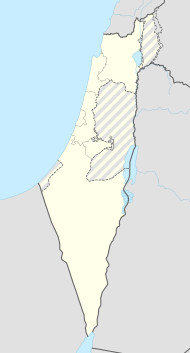Modi .in
| Modi'in | ||
|---|---|---|
|
||

|
||
| Basic data | ||
| hebrew : | מודיעין | |
| arabic : | موديعين | |
| State : |
|
|
| District : | Central | |
| Founded : | 1996 | |
| Coordinates : | 31 ° 54 ' N , 35 ° 0' E | |
| Height : | 209 m | |
| Area : | 50.176 km² | |
| Residents : | 92,406 (as of 2018) | |
| Population density : | 1,842 inhabitants per km² | |
| Community code : | 1200 | |
| Time zone : | UTC + 2 | |
| Postal code : | 71695-71799 | |
| Community type: | city | |
|
|
||
Modi'in ( Hebrew מודיעין[mɔdi'ʔin], Arabic موديعين, DMG Mūdīʿīn ) is a city in Israel . It is located in the central district and at the end of 2002 had almost 35,000 inhabitants. According to the Israel Central Statistical Office, the population reached 76,500 in April 2005 and 92,406 in 2018.
Modiʿin maintains a town partnership with Hagen in Westphalia and also maintains a youth exchange with the municipality of Ammerthal in the Bavarian Upper Palatinate .
location
Modiʿin is located at the foot of the Judean Mountains, 300 m above sea level, halfway between Tel Aviv and Jerusalem , 15 minutes by car from Ben Gurion Airport . The city is on the edge of the West Bank , on the so-called Green Line . The country used to belong to five Palestinian villages: Ni'lin, Kharbata, Saffa, Bil'in and Dir Qadis.
In the north there is the Samaria mountain range , in the south the fertile Schefela plain.
Nearby was the biblical Modeïn / Modin , the home of Mattatias , the father of Judas Maccabeus , ancestor of the Hasmonean kings of Judah ( 1 Makk 2.15 EU ). The exact location of the ancient place is not known.
Planning concept
The planned town of Modiʿin is built according to a concept that is derived from its topography :
- The residential areas are on the many hills of the city.
- The valleys (“Amakim” in Hebrew ) are green areas in which schools, sports areas, small shopping centers etc. are built. The main traffic arteries also run there.
- High-rise buildings are only allowed on the hilltops.
- The original topography is not changed; the city adapts to it.
- The houses on the slopes are terraced.
population
The modern mode is so new that it cannot be found on many maps yet. The first settlers moved in 1996; the target planning envisages a population of 240,000, with "clean" industry and lots of grassland. When the planned population is reached, Modiʿin will be one of the largest cities in Israel.
According to Israel's Central Bureau of Statistics (CBS), the 2001 population was 43.8% between 0-19 years old, 12.5% 20-29 year olds, 31.9% 30-44 Year-olds, 8.0% from 45 to 59 year olds, 1.4% from 60 to 64 year olds and 2.3% from 65 year olds and older people. The population growth in 2001 was 13.5%.
Web links
- Website of the city of Modiʿin
- Doris Lambers-Petry: Modeïn. In: Michaela Bauks, Klaus Koenen, Stefan Alkier (Eds.): The Scientific Biblical Lexicon on the Internet (WiBiLex), Stuttgart 2006 ff.
Individual evidence
- ↑ אוכלוסייה ביישובים 2018 (population of the settlements 2018). (XLSX; 0.13 MB) Israel Central Bureau of Statistics , August 25, 2019, accessed May 11, 2020 .
- ↑ אוכלוסייה ביישובים 2018 (population of the settlements 2018). (XLSX; 0.13 MB) Israel Central Bureau of Statistics , August 25, 2019, accessed May 11, 2020 .





